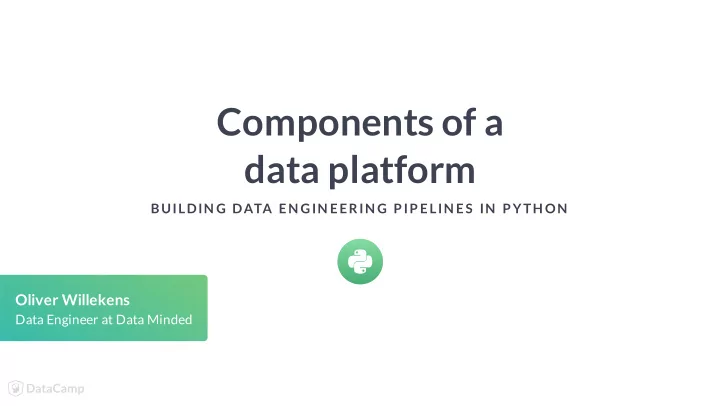

Components of a data platform BUILDIN G DATA EN GIN EERIN G P IP ELIN ES IN P YTH ON Oliver Willekens Data Engineer at Data Minded
Course contents ingest data using Singer apply common data cleaning operations gain insights by combining data with PySpark test your code automatically deploy Spark transformation pipelines => intro to data engineering pipelines BUILDING DATA ENGINEERING PIPELINES IN PYTHON
Data is valuable BUILDING DATA ENGINEERING PIPELINES IN PYTHON
Democratizing data increases insights BUILDING DATA ENGINEERING PIPELINES IN PYTHON
Genesis of the data BUILDING DATA ENGINEERING PIPELINES IN PYTHON
Operational data is stored in the landing zone BUILDING DATA ENGINEERING PIPELINES IN PYTHON
Cleaned data prevents rework BUILDING DATA ENGINEERING PIPELINES IN PYTHON
The business layer provides most insights BUILDING DATA ENGINEERING PIPELINES IN PYTHON
Pipelines move data from one zone to another BUILDING DATA ENGINEERING PIPELINES IN PYTHON
Let’s reason! BUILDIN G DATA EN GIN EERIN G P IP ELIN ES IN P YTH ON
Introduction to data ingestion with Singer BUILDIN G DATA EN GIN EERIN G P IP ELIN ES IN P YTH ON Oliver Willekens Data Engineer at Data Minded
Singer’s core concepts Aim: “The open-source standard for writing scripts that move data” Singer is a speci�cation data exchange format: JSON extract and load with taps and targets => language independent BUILDING DATA ENGINEERING PIPELINES IN PYTHON
Singer’s core concepts Aim: “The open-source standard for writing scripts that move data” Singer is a speci�cation data exchange format: JSON extract and load with taps and targets => language independent communicate over streams : schema (metadata) state (process metadata) record (data) BUILDING DATA ENGINEERING PIPELINES IN PYTHON
Singer’s core concepts Aim: “The open-source standard for writing scripts that move data” Singer is a speci�cation data exchange format: JSON extract and load with taps and targets => language independent communicate over streams : schema (metadata) state (process metadata) record (data) BUILDING DATA ENGINEERING PIPELINES IN PYTHON
Describing the data through its schema columns = ("id", "name", "age", "has_children") users = {(1, "Adrian", 32, False), (2, "Ruanne", 28, False), (3, "Hillary", 29, True)} json_schema = { "properties": {"age": {"maximum": 130, "minimum": 1, "type": "integer"}, "has_children": {"type": "boolean"}, "id": {"type": "integer"}, "name": {"type": "string"}}, "$id": "http://yourdomain.com/schemas/my_user_schema.json", "$schema": "http://json-schema.org/draft-07/schema#"} BUILDING DATA ENGINEERING PIPELINES IN PYTHON
Describing the data through its schema import singer singer.write_schema(schema=json_schema, stream_name='DC_employees', key_properties=["id"]) {"type": "SCHEMA", "stream": "DC_employees", "schema": {"properties": {"age": {"maximum": 130, "minimum": 1, "type": "integer"}, "has_children": {"type": "boolean"}, "id": {"type": "integer"}, "name": {"type": "string"}}, "$id": "http://yourdomain.com/schemas/my_user_schema.json", "$schema": "http://json-schema.org/draft-07/schema#"}, "key_properties": ["id"]} BUILDING DATA ENGINEERING PIPELINES IN PYTHON
Serializing JSON import json json.dumps(json_schema["properties"]["age"]) '{"maximum": 130, "minimum": 1, "type": "integer"}' with open("foo.json", mode="w") as fh: json.dump(obj=json_schema, fp=fh) # writes the json-serialized object # to the open file handle BUILDING DATA ENGINEERING PIPELINES IN PYTHON
Let’s practice! BUILDIN G DATA EN GIN EERIN G P IP ELIN ES IN P YTH ON
Running an ingestion pipeline with Singer BUILDIN G DATA EN GIN EERIN G P IP ELIN ES IN P YTH ON Oliver Willekens Data Engineer at Data Minded
Streaming record messages columns = ("id", "name", "age", "has_children") users = {(1, "Adrian", 32, False), (2, "Ruanne", 28, False), (3, "Hillary", 29, True)} singer.write_record(stream_name="DC_employees", record=dict(zip(columns, users.pop()))) {"type": "RECORD", "stream": "DC_employees", "record": {"id": 1, "name": "Adrian", "age": 32, "has_children": false}} fixed_dict = {"type": "RECORD", "stream": "DC_employees"} record_msg = {**fixed_dict, "record": dict(zip(columns, users.pop()))} print(json.dumps(record_msg)) BUILDING DATA ENGINEERING PIPELINES IN PYTHON
Chaining taps and targets # Module: my_tap.py import singer singer.write_schema(stream_name="foo", schema=…) singer.write_records(stream_name="foo", records=…) Ingestion pipeline: Pipe the tap’s output into a Singer target, using the | symbol (Linux & MacOS) python my_tap.py | target-csv python my_tap.py | target-csv --config userconfig.cfg my-packaged-tap | target-csv --config userconfig.cfg BUILDING DATA ENGINEERING PIPELINES IN PYTHON
Modular ingestion pipelines my-packaged-tap | target-csv my-packaged-tap | target-google-sheets my-packaged-tap | target-postgresql --config conf.json tap-custom-google-scraper | target-postgresql --config headlines.json BUILDING DATA ENGINEERING PIPELINES IN PYTHON
Keeping track with state messages BUILDING DATA ENGINEERING PIPELINES IN PYTHON
Keeping track with state messages id name last_updated_on 1 Adrian 2019-06-14T14:00:04.000+02:00 2 Ruanne 2019-06-16T18:33:21.000+02:00 3 Hillary 2019-06-14T10:05:12.000+02:00 singer.write_state(value={"max-last-updated-on": some_variable}) Run this tap-mydelta on 2019-06-14 at 12:00:00.000+02:00 (2nd row wasn’t yet present then): {"type": "STATE", "value": {"max-last-updated-on": "2019-06-14T10:05:12.000+02:00"}} BUILDING DATA ENGINEERING PIPELINES IN PYTHON
Let’s practice! BUILDIN G DATA EN GIN EERIN G P IP ELIN ES IN P YTH ON
Recommend
More recommend